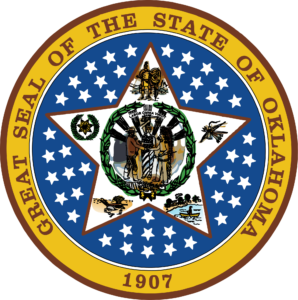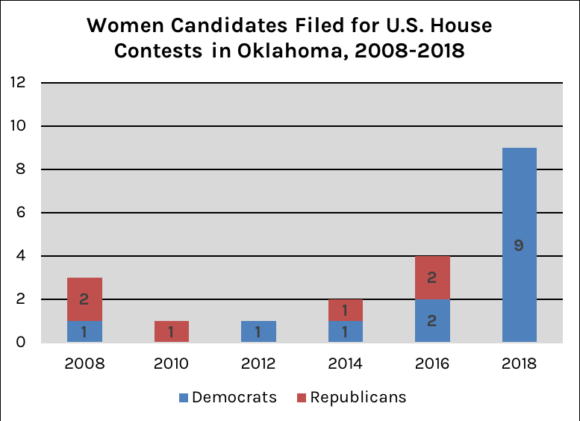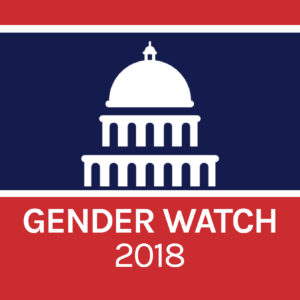 Ahead of the Oklahoma primary election on June 26, 2018, we outline the numbers and proportions of women who have filed as candidates for congressional and statewide office. The data below also provide points of historical comparison to give context to today’s presence and potential success of women candidates.
Ahead of the Oklahoma primary election on June 26, 2018, we outline the numbers and proportions of women who have filed as candidates for congressional and statewide office. The data below also provide points of historical comparison to give context to today’s presence and potential success of women candidates.
All data are provided from the Center for American Women and Politics, Eagleton Institute of Politics, Rutgers University. For a full list of the women candidates in Oklahoma primary races for congressional and statewide offices, see CAWP’s Election Watch page.
CONGRESS
Current: 0 of 7 members of the Oklahoma congressional delegation (0%)
Filed: 9 (9D)
Percent of all Filed Congressional Candidates (D/R): 25% (9 of 36)
* Oklahoma is one of 11 current states that have no women representing it in Congress.
SENATE
Current: 0 of 2 senators
No woman has ever served in the U.S. Senate from Oklahoma.
THERE IS NO U.S. SENATE CONTEST IN OKLAHOMA THIS YEAR.
HOUSE
Current: 0 of 5 representatives (0%)
- 2 (2R) women have served in the U.S. House from Oklahoma; Alice Mary Robertson (R) served from 1921-1923 and Mary Fallin served from 2007-2011.
Filed: 9 (9D)
- 2 (2D) woman are running for the Democratic nomination for the open seat in Oklahoma’s 1st congressional district.
- 7 (7D) women are running as challengers in 3 districts, seeking the Democratic nomination to challenge Republican incumbents in November.
* 2 (2D) of 9 women candidates for U.S. House from Oklahoma identify as women of color, including 1 Black woman (Gwendolyn Fields) and 1 multiracial woman (Amanda Douglas) who identifies as Native American and White. Oklahoma has never sent a woman of color to Congress.
Districts with Women Candidates: 4 of 5
Percent of all Filed House Candidates (D/R): 25% (9 of 36)
Percent of all Filed Democratic House Candidates: 42.9% (9 of 21)
Percent of all Filed Republican House Candidates: 0% (0 of 15)

Recent history: The number of women who filed for major party candidacy for the U.S. House in Oklahoma in 2018 is greater than any other year between 2008 and 2018. There is one open seat contest for the U.S. House in Oklahoma in 2018. In 2014, when one seat was open, just 2 (1D, 1R) competed for major party nominations.
- This year marks the highest number of Democratic women, but not of Republican women, running for the U.S. House in Oklahoma between 2008 and 2018.
GOVERNOR
Current: 1
Current Governor Mary Fallin (R) is the first woman governor of Oklahoma. She is term-limited and will not run for re-election this year.
Filed: 1 (1D)
- Former State Senator Connie Johnson (D) is the only woman running for governor in Oklahoma this year. Identifying as both Black and Native American, Johnson would be the first woman of color elected statewide in Oklahoma.
Percent of all Filed Gubernatorial Candidates (D/R): 8.3% (1 of 12)
Percent of all Filed Democratic House Candidates: 50% (1 of 2)
Percent of all Filed Republican House Candidates: 0% (0 of 10)
OTHER STATEWIDE ELECTED EXECUTIVE OFFICES
Current: 3 (3R) of 10 positions (excludes governor) (30%)
- Incumbent Superintendent of Public Instruction Joy Hofmeister (R) is running for re-election, while incumbent Corporation Commissioner Dana Murphy (R) is running for lieutenant governor. Incumbent Commissioner of Labor Melissa McLawhorn Houston (R), who was appointed in 2017, is not running to keep the position.
Filed: 11 (4D, 7R)
- 1 (1R) incumbent (Superintendent of Public Instruction Joy Hofmeister) is running for re-election.
- 7 (3D, 4R) women are running in open seat contests for lieutenant governor, insurance commissioner, commissioner of labor, and auditor.
- 2 (2R) women are running against incumbents of their own party for Republican nominations for attorney general and superintendent of public instruction.
- 1 (1D) woman is running for the Democratic nomination to challenge Republican incumbent Corporation Commissioner Bob Anthony.
Percent of all Filed Statewide Executive (other than governor) Candidates (D/R): 33.3% (11 of 33)
Percent of all Filed Democratic Statewide Executive (other than governor) Candidates: 36.4% (4 of 11)
Percent of all Filed Republican Statewide Executive (other than governor) Candidates: 31.8% (7 of 22)
Recent history: The number of women who filed for major party candidacy for the statewide executive offices (other than governor) in Oklahoma is higher than in any other year between 2008 and 2018. In the decade before 2018, the highest number of major party women candidates for statewide executive offices (other than governor) in Oklahoma was 4 in 2014 and 2010.
* At least 4 (4D) women candidates for statewide executive office in Oklahoma, including governor, are women of color, including 1 Black woman, 2 women who identify as both Black and Native American, and 1 Native American woman. No woman of color has ever been elected statewide in Oklahoma.


 From March to December 2018, the
From March to December 2018, the 